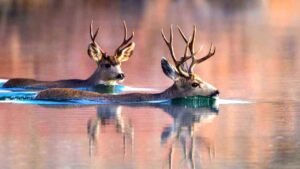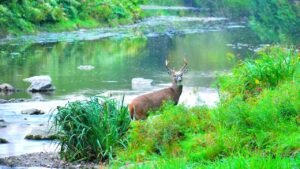Do you think that deer are just as good in the water as they are on land? Just like me, are you curious to know if they can swim? Read on and discover some shocking facts about deer.
In addition to being very fast on land, deer are equally fast in the water. Yes, deer are exceptional swimmers. They swim about 15 mph. Sometimes they cross rivers and lakes looking for food or to reach safety. If necessary, deer can swim long distances, such as in the ocean.
Deer have very strong leg muscles, toes, and hooves that help them to be good swimmers. Without strong leg muscles, deer would not be so good.
Although all species of deer are excellent swimmers, they live on land, but some species live in shallow areas of rivers, such as Chinese water deer (Hydropotes inermis inermis) and Korean water deer (Hydropotes inermis argyropus).
How do deer become skilled swimmers?

It is possible for deer to swim long distances because:
In their coats, they have a natural flotation device
Deer have two coats, an undercoat and a topcoat. The undercoat is very dense and woolly, which is why they can swim for long distances and hours.
When deer spend a long time in the water, it provides great insulation from the heat-draining effects. The topcoat, though, is hollow, long, and sir-filled.
Because of these topcoat hairs, one-third of the deer’s body remains above water, which reduces the amount of energy needed to propel the deer against water resistance.
Swimming is an appropriate activity for their body shape
A deer’s coat is designed to help it float, as mentioned in the earlier pointer. Deer’s hind legs are also extremely powerful. In addition to their stamina and power, they are able to swim up to 10 miles, allowing them to cross huge lakes and rivers. Their hind legs give them an advantage when swimming.
How Do Deer Cross Wide Water Bodies?

The muscles in the ears of deer allow them to move independently in accordance with their head movements. A deer’s high sense of smell alerts them to predators lurking in its vicinity. Wildlife experts and a variety of biologists have noted that deer tend to take to water when they are frightened.
It also takes to the water to find food and shelter, which would be unavailable to predators that cannot swim when frightened.
In many cases, pregnant female deer swim to small islands to find a safe place to deliver their fawns. Deer can swim for miles without tiring out.
Swamp ground is a favourite of swimmer deer
As a result of their concern about their safety, deer swap to make sure they are safe. The swamp is the best place for deer as it allows them to bed in thick, dense growth. Because of the sound created by the dense marsh growth, predators and hunters can be heard when they approach the swamp ground.
It is very easy for deer to run in any direction on hearing hunters/predators. Deer prefer swamps due to their bounding ability and long legs that allow them to outrun intruders quickly.
The deer primarily walk on firm ground, but they use the swamp for normal travel routes. They know that they can outsmart their predators only in muddy terrain. Deer don’t swim unless it is extremely necessary. As a way to escape hunting pressure or for food, they volunteer to swim on an island.
The Brilliant Swimmers, the Water Deer

Water deer are deer that are small in size but appear very much like musk deer. Water deer have two subspecies that are native to Korea and China.
Hydropotes inermis argyropus is the Korean Water Deer.
Hydrapotes inermis inermis-Chinese water Deer
Korean Water Deer are found everywhere in Korea since their natural predators (Korean leopards and Korean Tigers) are becoming extinct, while Chinese Water Deer are extinct in western and southern parts of China. There are several places in China where Water Deer can be found, including Anhui, Hubei, Shanghai, Fujian, and others.
In the United Kingdom, the United States, and France, the Chinese Water Deer can be seen alongside rivers in areas where they are well protected by tall rushes and reeds.
Water Deer are also found in mountains, grasslands, swamps, and even in open cultivated fields. As their name suggests, they are friendly with water and excellent swimmers.
Water Deer Physical Appearance
Water Deer are gifted with narrow pelvic and pectoral girdles, a long neck and long legs. Their hind legs are longer and stronger than their front legs, so the haunches are carried higher than the shoulders while swimming.
Unlike other deer, water deer jump like rabbits. Their tail is almost invisible, about 5 to 10 cm long. Their ears are rounded and not too long. Water deer do not grow antlers.
During the winter, the coarse-haired, thicker coat replaces the summer coat, which could be greyish brown colour or light brown colour. The young Water Deer are born with dark brown coats with white stripes and spots.
Water Deer have protruding long canine teeth. These canines are developed in the upper jaw. These teeth are not present from birth. They erupt usually after the young deer is about 6 months old.
Water deer can control their long canines with their facial muscles when they are about two years old. The long canines of these deer are barely held in the gum socket.
During aggressive encounters, the Water Deer displays his weapon by pulling his lower lip backward and pulling his teeth closer together. Due to these canines, the Water Deer has another name: Vampire Deer.
Water deer behaviour
Male Water Deer are highly territorial. They mark their territory with urine and feces. Females are not territorial during normal times, but during breeding season they form small groups.
They disperse when they see the danger. Water Deer females are very aggressive immediately before and after giving birth to their young. If they come anywhere near their birth territory, they will be driven away.
A female Water Deer produces two or three young ones on average. A doe gives birth to her young ones in the open, but soon after they are born, they are moved to an area covered in vegetation so that predators cannot see them. Sometimes, there are even seven young ones.
What are the ways in which water deer communicate?

During communication, Water Deer make a variety of sounds. Its main sound is the bark. It barks when it sees danger or is trying to communicate with other Water Deer.
Can Deer swim in the ocean? It is possible for deer to swim in oceans and deep water without drowning. Due to its strong legs, a deer can jump fences as high as 9 feet and run at about 40 miles per hour, as well as its two-layered coat that contains hollow hair, which gives it buoyancy.
Can Deer swim underwater? It is possible for some species of deer to swim underwater, but not all species. Mouse-Deer is seen swimming very comfortably underwater.
Are baby Deer good swimmers too? The baby deer can swim, but because they are inexperienced and small, they tend to exhaust themselves quickly.
Do Deer like swimming? Swimming is not a pleasant activity for deer. They swim in search of food, shelter, or to escape predators.








